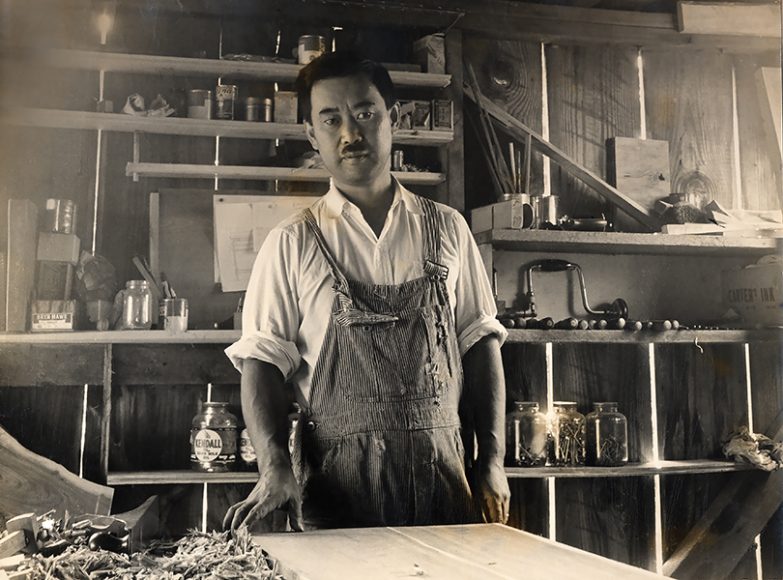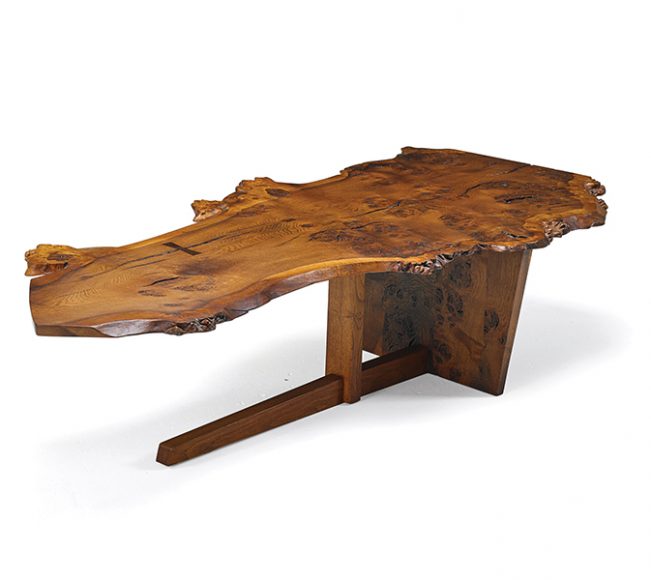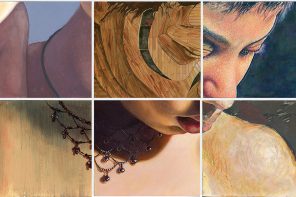While the value of much traditional “brown furniture” has seen a precipitous decline over the last few years, that’s not the case for American craft furniture and the works of George Nakashima in particular. Current auction values can exceed $50,000 for a coffee table or hanging wall case.
Nakashima’s furniture is known for high quality craftsmanship and his synthesis of Japanese design and manufacturing technique with Modernism. His selection of wood was of paramount importance, as Nakashima believed that the spirit of the tree informed the design of the resulting piece of furniture. The board’s free edges, knots and burls were celebrated, with fissures emphasized and stabilized with exquisite joinery.
Nakashima (1905-1990) was born in Spokane, Washington, and trained as an architect. He worked in Japan and India for Antonin Raymond before returning to the United States. During World War II, Nakashima and his family were interned at Minidoka, Idaho, where he learned traditional Japanese carpentry from another skilled woodworker. With Antonin Raymond’s sponsorship, Nakashima was released in 1943 and came to work at Raymond’s farm in New Hope, Pennsylvania.
There in the Delaware Valley, Nakashima established his workshop. In addition to working on private commissions, he also designed for Knoll and the Widdicomb Furniture Co.
While much of Nakashima’s furniture found a devoted local following in the Delaware Valley, it’s also often found in mid-century houses of Westchester County and Connecticut and beyond. Nakashima’s most prestigious private commission was former Vice President and New York state Gov. Nelson A. Rockefeller’s Japanese House. Built on the grounds of Kykuit, the Rockefeller family’s historic estate in Pocantico Hills, it contains some 150 Nakashima pieces.
Today, Nakashima’s daughter Mira continues to design for and run the firm. The workshop has been designated a national historic landmark and the Nakashima Foundation has put in place plans to ensure the preservation, protection and perpetuation of the Nakashima legacy.
Nakashima rarely signed his work. Sometimes his signature or the client’s name is found in marker on the underside of a piece. Yet the firm’s meticulous record keeping ensures that unsigned pieces can be authenticated.
What makes one Nakashima piece so much more valuable than one of his other works? An object produced for private commission will always be more desirable than a factory-production piece by Knoll or Widdicomb. A signed piece and a notable provenance also certainly add value. Rarity of form is another factor. According to David Rago, founder of Rago Arts and Auction, Nakashima mainly designed dining tables, chairs, sideboards and coffee tables. Prices start to rise once you move beyond these basic four forms. For example, a rare Nakashima table lamp can bring $16,000 at auction.
But it is Nakashima’s choice of wood, his embrace of free edges and fissures and the degree to which he applied his exceptional joinery that makes all the difference between a $20,000 and a $50,000 coffee table. Rago says that the more elaborate the wood, the greater the value. A free-edge burl dining table is more valuable than a straight-edged table, while a set of dining chairs made of rosewood or exotic wood can also enhance the price. The bases used on Nakashima dining and coffee tables also matter greatly — the more complex, the better. A simple, Shaker-style base is less valuable than an architecturally resplendent Conoid on Minguren base.
So who is buying these pieces? According to Rago, the market was once mainly domestic but has become increasingly international. Higher prices at auction have been driven more recently by European buyers, especially the French. Rago notes that approximately 250 pieces a year are being exported to England, Italy, Belgium and France.
And it’s not just collectors like Michael Kors who are passionate about Nakashima’s work. Interior designers and their clients are fans of Nakashima. William Cullum of Jayne Design Studio notes the pieces act as an overt foil to the architecture. He explains that while there have been many imitators of Nakashima’s work, when you see the free-form edge of an original Nakashima piece, you immediately understand its appeal.
Jennifer Pitman, a Westchester resident, writes about the antiques, jewelry and fine art she encounters as Rago Arts and Auction’s senior account manager for Westchester and Connecticut. She can be reached at jenny@ragoarts.com or 917-745-2730.






